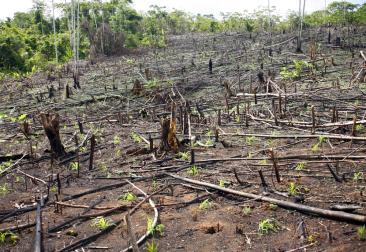
One of the worst ecological horror stories of recent decades has been the deforestation of the Amazon. It’s bad enough that human clearing of the forest is devastating for wildlife conservation in this fantastically biodiverse environment. The bigger picture is that the lush growth of the Amazon basin serves as a carbon sink for the whole planet, capturing carbon from the at
mosphere in a natural process of carbon sequestration that helps combat climate change. We all rely on the Amazon to keep the planet green and clean. Fortunately, Brazil seems to be winning the battle to conserve the planet’s ‘green lungs’ by stopping its deforestation.
For decades farmers have been clearing Amazonian forest land for agriculture. In the 1990s this was happening on an unprecedented scale, with an area the size of Spain cleared in ten years. Although some of the damage was due to big business and ranching interests, small farmers eking out a modest living were also major contributors. Twenty-five million people live in the Brazilian Amazon, and the government has had a hard balancing act in sorting out the competing interests of economic and agricultural development and conservation.
The latest figures show that they seem to be getting it right. The government’s figures show an all-time low in forest area stripped away in 2012. , The problem has by no means gone away, as Brazil is poised to become the world’s biggest soy producer, but controls seem to be slowing deforestation – down 80% in eight years. At the forefront of Brazil’s efforts is a program of strict monitoring and control, with high tech equipment and a strong green policing initiative to fight climate change.
Officers from Ibama, the official environmental agency, are equipped with the technology to monitor deforestation using satellite imaging. They are then in a position to swoop on people clearing land illegally, by burning or clearance with tractors and chains. It’s not the ideal, which would be preventive measures, but it does allow quick intervention. New satellites, developed in collaboration with Japan and China, will improve the speed and quality of data gathering.
The environmental officers are also equipped with a range of powers to punish people who illegally clear land, although few of the fines levied ever get paid and canny offenders launch time-consuming appeals. Still, the new super-efficient technology means it’s harder to get away with it than ever before, and does seem to act as a real deterrent.
There are more threats ahead, unfortunately. The rising demand for soy to feed the world’s populations means that there’s a real economic incentive farmers to flout the rules. Brazil’s resolve in resisting the temptation to cash in will no doubt be sorely tested by the prospect of prosperity. Still, global pressure and international assistance to limit deforestation in the interests of preventing climate change may be effective in preserving the Amazonian environment for the future. One of the worst ecological horror stories of recent decades has been the deforestation of the Amazon. It’s bad enough that human clearing of the forest is devastating for wildlife conservation in this fantastically biodiverse environment. The bigger picture is that the lush growth of the Amazon basin serves as a carbon sink for the whole planet, capturing carbon from the atmosphere in a natural process of carbon sequestration that helps combat climate change. We all rely on the Amazon to keep the planet green and clean. Fortunately, Brazil seems to be winning the battle to conserve the planet’s ‘green lungs’ by stopping its deforestation.
For decades farmers have been clearing Amazonian forest land for agriculture. In the 1990s this was happening on an unprecedented scale, with an area the size of Spain cleared in ten years. Although some of the damage was due to big business and ranching interests, small farmers eking out a modest living were also major contributors. Twenty-five million people live in the Brazilian Amazon, and the government has had a hard balancing act in sorting out the competing interests of economic and agricultural development and conservation.
The latest figures show that they seem to be getting it right. The government’s figures show an all-time low in forest area stripped away in 2012. , The problem has by no means gone away, as Brazil is poised to become the world’s biggest soy producer, but controls seem to be slowing deforestation – down 80% in eight years. At the forefront of Brazil’s efforts is a program of strict monitoring and control, with high tech equipment and a strong green policing initiative to fight climate change.
Officers from Ibama, the official environmental agency, are equipped with the technology to monitor deforestation using satellite imaging. They are then in a position to swoop on people clearing land illegally, by burning or clearance with tractors and chains. It’s not the ideal, which would be preventive measures, but it does allow quick intervention. New satellites, developed in collaboration with Japan and China, will improve the speed and quality of data gathering.
The environmental officers are also equipped with a range of powers to punish people who illegally clear land, although few of the fines levied ever get paid and canny offenders launch time-consuming appeals. Still, the new super-efficient technology means it’s harder to get away with it than ever before, and does seem to act as a real deterrent.
There are more threats ahead, unfortunately. The rising demand for soy to feed the world’s populations means that there’s a real economic incentive farmers to flout the rules. Brazil’s resolve in resisting the temptation to cash in will no doubt be sorely tested by the prospect of prosperity. Still, global pressure and international assistance to limit deforestation in the interests of preventing climate change may be effective in preserving the Amazonian environment for the future.

